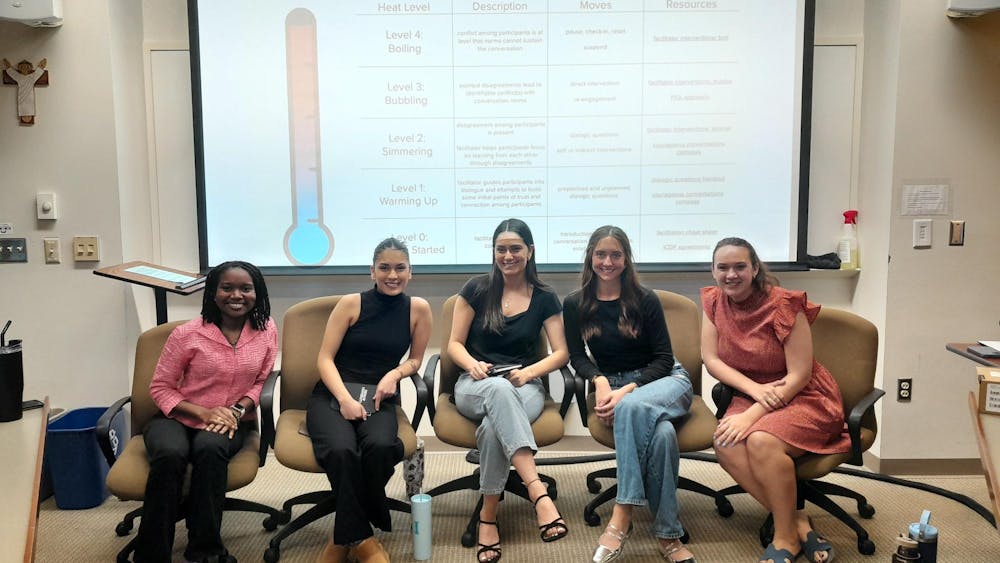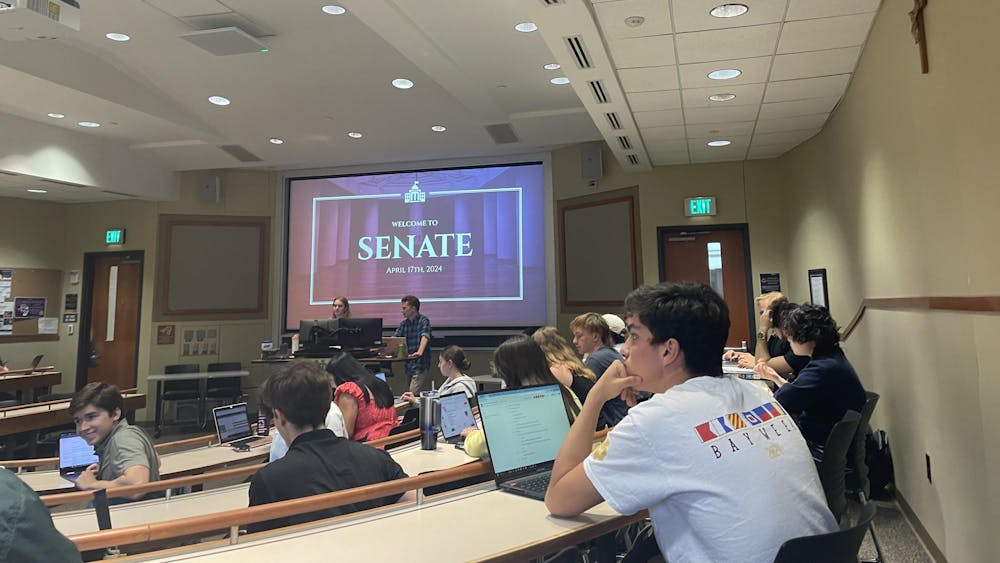Editor’s note: This is the fourth day in a series on disability at Notre Dame and Saint Mary’s. Today’s stories focus on student experiences with physical accessibility at the College and University.
Scott Howland, coordinator in the office of Disability Services, said all current academic buildings are accessible for students with physical disabilities, aside from Riley Hall, which is home to the art, art history and design department.
“If a student would have a class in that building, we would move it to a different location,” he said.
Howland said when he came to the University in the 1990s, the Mod Quad residence halls — Pasquerilla East, Pasquerilla West, Knott and Siegfried Hall — were the most physically accessible dorms.
“Right when I started, they were building Keough and McGlinn and Welsh Family. Those were kind of the ideal, at that point, to place students in,” he said. “And Ryan Hall — the Ryan family was very interested in accessibility, so they ensured that a lot of things were put in place for Ryan that were fully accessible.”
University architect Doug Marsh said the Americans with Disabilities Act (ADA), which was passed in 1990 and took effect in 1992, has facility and “built-environment” requirements. The state of Indiana also has separate accessible design criteria, and though the two codes are usually consistent, there are small differences.
“Any building after 1992 is considered new construction and needs to be barrier-free,” he said.
Jessica Ping is a freshman at Notre Dame who has CHILD syndrome, a limb and skin deficiency, and has only partial limbs on her left side.
“In order to get around for long distances, I have to use a chair or a prosthetic, which I don’t use very often because of the skin thing. Most of the time, I just use the chair. I can hop short distances,” she said.
Ping lives in a quad in McGlinn Hall, but has her own room that has buttons allowing her to leave and enter more easily, as well as a shower with similar modifications. She will be living in the new women’s residence hall that will open in the fall of 2016.
“Other than that, I’m not going to lie — McGlinn is supposedly one of the most accessible dorms, but I’ve had an awful time with it. It’s been really bad. The snow situation was just awful this year, with the parking lot out in front and nobody was willing to do anything about it. So that’s one thing I’m not happy with,” she said.
Ping said the first snowfall of the year was on a Saturday night.
“I was hungry, the dining hall was about to close, but my rector said I wouldn’t be able to get out. She was right, I got stuck, had to be pushed back in,” she said. “Long story short, we ended up calling NDSP to see if they could give me a ride in one of the cop cars to the dining hall, and they just threw a fit about it. They were so rude to myself, my roommates and my rector. They were unbelievably terrible to deal with and I didn’t try ever again with them.
“But I did keep in contact with the disability services on campus and was like, ‘Hey, I’m having issues with the snow, can you fix it?’ And they always tried to word it in a way like they were really sorry, but they weren’t going to fix it,” she said.
Marsh said the University has also worked to identify barriers in buildings that were constructed before 1992 and create a program to remove those barriers. Notre Dame’s historic campus, with more than 100 buildings constructed before 1992, presents unique challenges. For example, Alumni Hall, a men’s residence hall constructed in 1931, is sunk in the ground and has a “mid-level” entry.
“They do each have those ramped entrances so people can get on the main level, but again, there’s the chapel, now has three steps down to step into.” he said. “You remove as many barriers as physically possible, but some just aren’t achievable.”
Ping said the lack of working elevators in other residence halls, like Lyons, has kept her from being able to visit friends in their own dorms.
“I can hop up the stairs, but I don’t feel comfortable, especially at night, leaving my chair outside for any passerby to mess around with,” she said.
Megan Crowley, a freshman in Ryan Hall with Pompe disease, which progressively weakens muscles, said she specifically looked at wheelchair accessibility when she was visiting college campuses as a prospective student.
Editor’s note: Crowley spoke to The Observer with the assistance of her nurse, Debbie Larsen, who is quoted below.
“Some of the colleges were not accessible, so those got crossed off the list. Notre Dame was one of the ones that was really accommodating to her,” Larsen said.
Crowley said she has a parking space for her wheelchair-accessible van and special access to closer spaces for some buildings. She also has her own room in Ryan Hall.
“Because she needs her own shower, she has a nurse twenty-four hours a day with her, and she needed the space as well for all the equipment and to accommodate her needs,” Larsen said. “The room is just amazing because it has a shower, it has access to water, she has a remote that opens the dorm doors. It opens the main doors for her and it also opens her own dorm room so she can get in and out.”
Crowley said she is bothered by the fact that she might not be able to attend an event on campus because not all the buildings are wheelchair-accessible.
“... But at this point in her life, she’s accepted that there are going to be places that she can’t access and, if they can fix it, that’s great,” Larsen said. “But she does understand that some of these buildings are very old and they can’t be fixed. It’s not realistic for her to expect that everything in her life is going to be easy, and that everyone’s going to be able to accommodate her needs, and she understands that and is fine with that.”
Marsh said the University considers the requirements set forth by ADA and state codes to be minimums, and tries to exceed those minimums “in several key areas,” including ramp design.
While ramps are allowed to have “about an 8.3 percent” slope, ramps on the University’s new construction aim to have a maximum slope of five percent.
“It’s a big difference,” he said.”What these codes, and the ADA architectural provisions allow, is you to remove the railing because it’s such a subtle slope you don’t necessarily need it. From an aesthetic standpoint it doesn’t bring all this attention to the ramp, it’s just a subtle incline — you don’t need so many landings along the way. And, it’s more importantly, easier for people negotiate, depending on their disability.”
Transitions in floor material, such as going from carpet to tile, or vinyl to tile or a wood floor, is another issue the University tries to be cognizant of in new construction, Marsh said.
“Again, speaking with people who’ve endured these challenges, those transitions, even allowed, can be jarring or, depending on their condition, quite painful,” he said. “Ryan Hall was the first of its kind to have a no vertical floor transitions.
“We established different floor levels in the subfloor when we built the building, anticipating that the carpet is going to be this thick, but the tile is going to be this thick — we make the adjustment, so that when you roll across, or even if you’re walking but maybe have a malady that makes you drag your foot, it’s not a trip hazard to you. That’s not easy to do, but that’s our goal, to have a zero-transition change between flooring materials.”
The Department of Justice also issued updated requirements for accessible design in 2010, but these changes were “fairly subtle,” Marsh said.
“They didn’t change universal kinds of things, more dimensional, like the bathroom clearances changed. … It’s a matter of a few inches, but it’s important when you try to negotiate in a tight space,” he said. “Again it’s an area that we’re trying to make sure that restrooms and other small activity spaces, access to your offices are appropriate beyond the minimum, so if that change happens again, in the future, you don’t have that challenge.”
News writer Megan Valley contributed to this story.













